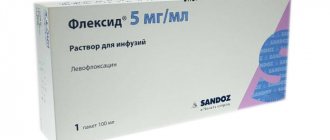Levofloxacin, 500 mg, film-coated tablets, 5 pcs.
Pills
Inside
without chewing and drinking a sufficient amount of liquid (from 0.5 to 1 glass), before meals or at any time between meals, because food intake does not affect the absorption of the drug (see section “Pharmacokinetics”). When selecting doses, tablets can be broken along the dividing groove.
The drug should be taken at least 2 hours before or 2 hours after taking antacids containing magnesium and/or aluminum, iron salts or sucralfate (see “Interactions”).
The dosage regimen is determined by the nature and severity of the infection, as well as the sensitivity of the suspected pathogen. The duration of treatment varies depending on the course of the disease.
Recommended dosage regimen and duration of treatment in patients with normal or moderately reduced renal function (Cl creatinine >50 ml/min.):
Sinusitis
(inflammation of the paranasal sinuses) - 2 tables. Tavanic® 250 mg or 1 tablet. Tavanic® 500 mg 1 time per day (corresponding to 500 mg levofloxacin) - 10–14 days.
Exacerbation of chronic bronchitis
- 1 table. Tavanic® 250 mg 1 time per day (corresponding to 250 mg of levofloxacin) or 2 tablets. Tavanic® 250 mg or 1 tablet. Tavanic® 500 mg 1 time per day (corresponding to 500 mg levofloxacin) - 7-10 days.
Community-acquired pneumonia
- 2 tables each Tavanic® 250 mg or 1 tablet. Tavanic® 500 mg 1-2 times a day (respectively 500-1000 mg of levofloxacin) - 7-14 days.
Uncomplicated urinary tract infections
- 1 table. Tavanic® 250 mg 1 time per day (corresponding to 250 mg of levofloxacin) - 3 days.
Prostatitis
- 2 tables each Tavanik ® 250 mg or 1 tablet. Tavanic® 500 mg 1 time per day (corresponding to 500 mg levofloxacin) - 28 days.
Complicated urinary tract infections, including pyelonephritis
, - 1 table. Tavanic® 250 mg 1 time per day (corresponding to 250 mg of levofloxacin) - 7-10 days.
Skin and soft tissue infections:
- 1 table. Tavanic® 250 mg 1 time per day (corresponding to 250 mg of levofloxacin) or 2 tablets. Tavanic® 250 mg or 1 tablet. Tavanic® 500 mg 1-2 times a day (respectively 500-1000 mg of levofloxacin) - 7-14 days.
Septicemia/bacteremia
- 2 tables each Tavanic® 250 mg or 1 tablet. Tavanic® 500 mg 1-2 times a day (respectively 500-1000 mg of levofloxacin) - 10-14 days.
Abdominal infections
- 2 tables each Tavanic® 250 mg or 1 tablet. Tavanic® 500 mg 1 time per day (corresponding to 500 mg levofloxacin) - 7-14 days (in combination with antibacterial drugs acting on anaerobic flora).
Comprehensive treatment of drug-resistant forms of tuberculosis
- 1-2 tables each. Tavanic® 500 mg 1-2 times a day (respectively 500-1000 mg of levofloxacin) - up to 3 months.
Levofloxacin is excreted primarily through the kidneys, therefore, when treating patients with impaired renal function, it is necessary to reduce the dose of the drug. Relevant information on this matter is contained in the table.
Dosage regimen
| Creatinine Cl, ml/min | Doses | ||
| Recommended dose for creatinine Cl more than 50 ml/min | 250 mg/24 h | 500 mg/24 h | 500 mg/12 h |
| 50–20 | first - 250 mg | first - 500 mg | first - 500 mg |
| then - 125 mg/24 hours | then - 250 mg/24 hours | then - 250 mg/12 hours | |
| 19–10 | first - 250 mg | first - 500 mg | first - 500 mg |
| then - 125 mg/48 hours | then - 125 mg/24 hours | then - 125 mg/12 hours | |
| <10 (including hemodialysis and CAPD*) | first - 250 mg | first - 500 mg | first - 500 mg |
| then - 125 mg/48 hours | then - 125 mg/24 hours | then - 125 mg/24 hours | |
* No additional doses are required after hemodialysis or continuous ambulatory peritoneal dialysis (CAPD).
Dosage regimen in patients with impaired liver function.
If liver function is impaired, no dosage adjustment is required, since levofloxacin is only slightly metabolized in the liver.
Dosage regimen in elderly patients.
For elderly patients, no dosage adjustment is required, except in cases where creatinine clearance decreases to 50 ml/min or lower.
Solution for infusion
IV,
drip, slowly (the duration of infusion of 100 ml with 500 mg of levofloxacin solution should be at least 60 minutes) - see “Special Instructions”. Depending on the patient’s condition, after a few days of treatment, you can switch from intravenous drip administration to taking the same dose of the drug in a form intended for oral administration.
Doses are determined by the nature and severity of the infection, as well as the sensitivity of the suspected pathogen. For patients with normal renal function (Cl creatinine >50 ml/min), the following dosage regimen can be recommended:
Community-acquired pneumonia
- 500 mg of levofloxacin 1-2 times a day (respectively 500-1000 mg of levofloxacin) - 7-14 days.
Complicated urinary tract infections (including pyelonephritis)
- 250 mg of levofloxacin 1 time per day (for severe infections, the dose may be increased) (respectively 250 mg of levofloxacin) - 7-10 days.
Uncomplicated urinary tract infections
- 250 mg of levofloxacin 1 time per day (respectively 250 mg of levofloxacin) - 3 days.
Chronic bacterial
prostatitis
- 500 mg of levofloxacin 1 time per day (respectively 500 mg of levofloxacin) - 28 days.
Septicemia/bacteremia
- 500 mg of levofloxacin 1-2 times a day (respectively 500-1000 mg of levofloxacin) - 10-14 days.
Abdominal infection
- 500 mg of levofloxacin 1 time per day (respectively 500 mg of levofloxacin) - 7-14 days (in combination with antibacterial drugs acting on anaerobic flora).
Comprehensive treatment of drug-resistant forms of tuberculosis
- 500 mg of levofloxacin 1-2 times a day (respectively 500-1000 mg of levofloxacin) - up to 3 months.
Levofloxacin is excreted primarily through the kidneys, therefore, when treating patients with impaired renal function, it is necessary to reduce the dose of the drug. Relevant information on this matter is contained in the table; for the solution for infusion, one should be guided by the dosage data presented in the columns 250 mg/24 hours and 500 mg/24 hours.
Tavanik®, solution for infusion 500 mg is compatible with the following infusion solutions: 0.9% sodium chloride solution, 5% dextrose solution, 2.5% Ringer's solution with dextrose, combined solutions for parenteral nutrition (amino acids, carbohydrates, electrolytes).
Tavanica® 500 mg solution should not be mixed with heparin or alkaline solutions (for example, sodium bicarbonate solution).
The duration of treatment, based on the course of the disease, should be no more than 14 days.
As with the use of other antibiotics, treatment with Tavanic® infusion solution is recommended for at least 48–78 hours after the body temperature has normalized or after the pathogen has been effectively destroyed.
Treatment with Tavanic® should not be interrupted or stopped early without a doctor's instructions.
Side effects of Levofloxacin
The most common adverse reactions are:
- digestive system disorders (nausea, diarrhea, vomiting, constipation);
- arterial hypotension (low blood pressure);
- headache;
- pain in the abdomen;
- local allergic reactions (redness of the skin, increased itching, urticaria);
- general weakness, increased fatigue.
If any adverse reactions develop after long-term use of Levofloxacin, it is recommended to consult with your doctor!
In this article, we found out what Levofloxacin helps with, as well as how to take it correctly.
Share on social networks
special instructions
When prescribing the drug to elderly patients, it should be borne in mind that patients in this group often have impaired renal function.
During treatment with Tavanic®, seizures may develop in patients with previous brain damage (including stroke or severe brain injury). Convulsive readiness may also increase with the simultaneous use of fenbufen, similar NSAIDs or theophylline.
When using the drug in patients with diabetes, it should be borne in mind that Tavanic® can cause hypoglycemia.
In severe pneumonia caused by pneumococcus, the use of Tavanic® may not be effective enough. Hospital-acquired infections caused by Pseudomonas aeruginosa may require combination therapy.
Despite the fact that photosensitivity is very rare with the use of levofloxacin, to prevent its development, patients should avoid exposure to the sun or UV irradiation.
If pseudomembranous colitis is suspected, Tavanic® should be immediately discontinued and appropriate treatment should be initiated. In such cases, drugs that inhibit intestinal motility should not be used.
In elderly patients, when using the drug Tavanic®, the likelihood of developing tendinitis increases. The use of corticosteroids appears to increase the risk of tendon rupture. If tendinitis is suspected, Tavanic® should be immediately discontinued and appropriate treatment should be initiated, ensuring the affected area remains at rest.
Tavanic® should be prescribed with caution simultaneously with probenecid and cimetidine, which block tubular secretion; under their influence, the elimination of levofloxacin is slightly slowed down. This interaction has virtually no clinical significance and may primarily affect patients with impaired renal function.
When using Tavanic and vitamin K antagonists simultaneously, it is necessary to monitor the state of the blood coagulation system.
When carrying out antibiotic therapy, changes in microflora (bacteria, fungi), which are normally present in humans, may be observed. For this reason, there may be an increased proliferation of bacteria and fungi that are resistant to the antibiotic used (secondary infection and superinfection), which in rare cases may require additional treatment.
Experience with other quinolones suggests that they can cause exacerbation of porphyria. A similar effect cannot be excluded when using the drug Tavanic®.
When using quinolones in patients with glucose-6-phosphate dehydrogenase deficiency, hemolysis of erythrocytes is possible. Considering this, treatment with Tavanik in this category of patients should be carried out with extreme caution.
The recommended duration of administration should be strictly adhered to, which should be at least 60 minutes for 100 ml of infusion solution. Experience with the use of levofloxacin shows that increased heart rate and a transient drop in blood pressure may occur during infusion. In rare cases, vascular collapse may occur. If a significant drop in blood pressure is observed during the infusion, the administration is stopped immediately.
Is it possible to take the antibiotic Levofloxacin for coronavirus?
A broad-spectrum antibiotic is prescribed for coronavirus in case of illness in an adult. The therapists have decided on the treatment regimen and know whether Levofloxacin can be taken for coronavirus. The answer is affirmative if there is purulent sputum and infection of the respiratory tract, pneumonia.
On a note!
In combination with Plaquenil, cardiac risks increase. This feature must be taken into account when prescribing to elderly people or patients suffering from heart disease.
Contraindications to the use of the drug TAVANIK®
- epilepsy;
- tendon lesions associated with a history of quinolone use;
- children and adolescents up to 18 years of age;
- pregnancy;
- lactation (breastfeeding);
- hypersensitivity to levofloxacin or other quinolones.
The drug should be used with caution in elderly patients due to the high likelihood of a concomitant decrease in renal function with glucose-6-phosphate dehydrogenase deficiency.
Overdose
Symptoms: confusion, dizziness, disturbances of consciousness and seizures similar to epileptic seizures, nausea, erosive lesions of the mucous membranes. In clinical and pharmacological studies, when using levofloxacin in doses exceeding the average therapeutic, prolongation of the QT interval was observed.
Treatment: carry out symptomatic therapy. Levofloxacin is not eliminated by dialysis. There is no specific antidote.
Mistakenly taking one extra 250 mg tablet of Tavanic® does not have a negative effect.
How does the treatment work?
The treatment regimen is as follows:
- The use of anti-tuberculosis drugs of choice, to which the sensitivity of Mycobacterium tuberculosis
is still preserved - isoniazid, rifampicin, ethambutol, pyrazinamide. These drugs are most effective and have the least toxicity. If resistance to isoniazid and rifampicin occurs, they are removed from the list; - The use of aminoglycosides that are highly bactericidal - kanamycin, amikacin. They are used parenterally and in maximum dosages;
- Fluoroquinolones are second-line drugs. They are safe, effective, and low cost. All these qualities make drugs of this group indispensable in the treatment of LTD;
- Other reserve drugs – PAS, cycloserine, ethionamide4
- To enhance the effect, use linezolid, clarithromycin, imepenem, amoxicillin clavulanate.
The effectiveness of treatment for LTD is much lower than the effectiveness of treatment for drug-sensitive tuberculosis.
And fluoroquinolones for the treatment of LUT, mainly levofloxacin is used, however, moxifloxacin can also be used for LUT, but only in the case of extensive drug resistance of the mycobacterium.
Fluoroquinolones are prescribed as continuous therapy for 20-24 months.
Pharmacokinetics
Suction
After oral administration, levofloxacin is quickly and almost completely absorbed from the gastrointestinal tract. Food intake has little effect on the speed and completeness of absorption.
With a single dose of 500 mg, Cmax in blood plasma is achieved after 1.3 hours and is 5.2-6.9 mcg/ml. Bioavailability - 100%.
After a 60-minute intravenous infusion of levofloxacin at a dose of 500 mg to healthy volunteers, the average Cmax in plasma was 6.2±1.0 mcg/ml, Tmax - 1.0±0.1 hours. The pharmacokinetics of levofloxacin is linear and predictable with single and repeated administration of the drug. The plasma profile of levofloxacin concentrations after intravenous administration is similar to that when taking tablets. Therefore, oral and intravenous routes of administration can be considered interchangeable.
Distribution
Plasma protein binding is 30-40%.
Penetrates well into organs and tissues: lungs, bronchial mucosa, sputum, urinary system organs, genitals, bone tissue, cerebrospinal fluid, prostate gland, polymorphonuclear leukocytes, alveolar macrophages.
The average Vd of levofloxacin ranges from 89 to 112 L after single and multiple intravenous administration at a dose of 500 mg.
Metabolism
In the liver, a small part of levofloxacin is oxidized and/or deacetylated.
Removal
After taking a single dose of 500 mg, T1/2 is 6-8 hours.
After a single intravenous administration at a dose of 500 mg T1/2 - 6.4±0.7 hours.
It is excreted primarily by the kidneys by glomerular filtration and tubular secretion.
The average final T1/2 ranges from 6 to 8 hours after single and multiple administrations.
About 87% of the dose is excreted unchanged in the urine within 48 hours. Less than 4% is found in feces over a period of 72 hours.
Pharmacokinetics in special clinical situations
In case of renal failure, a decrease in the clearance of the drug and its excretion by the kidneys depends on the degree of decrease in CC.
Drug interactions
Quinolones can enhance the ability of drugs (including fenbufen and similar NSAIDs, theophylline) to lower the seizure threshold.
The effect of Tavanic® is significantly reduced when used simultaneously with sucralfate, magnesium- or aluminum-containing antacids, as well as with iron salts (the interval between taking Tavanic and these drugs should be at least 2 hours). No interaction was detected with calcium carbonate.
With simultaneous use of vitamin K antagonists, monitoring of the blood coagulation system is necessary.
The elimination (renal clearance) of levofloxacin is slightly slowed down by the action of cimetidine and probenecid, which has virtually no clinical significance.
Tavanic® causes a slight increase in T1/2 of cyclosporine from blood plasma.
Concomitant use with GCS increases the risk of tendon rupture.





